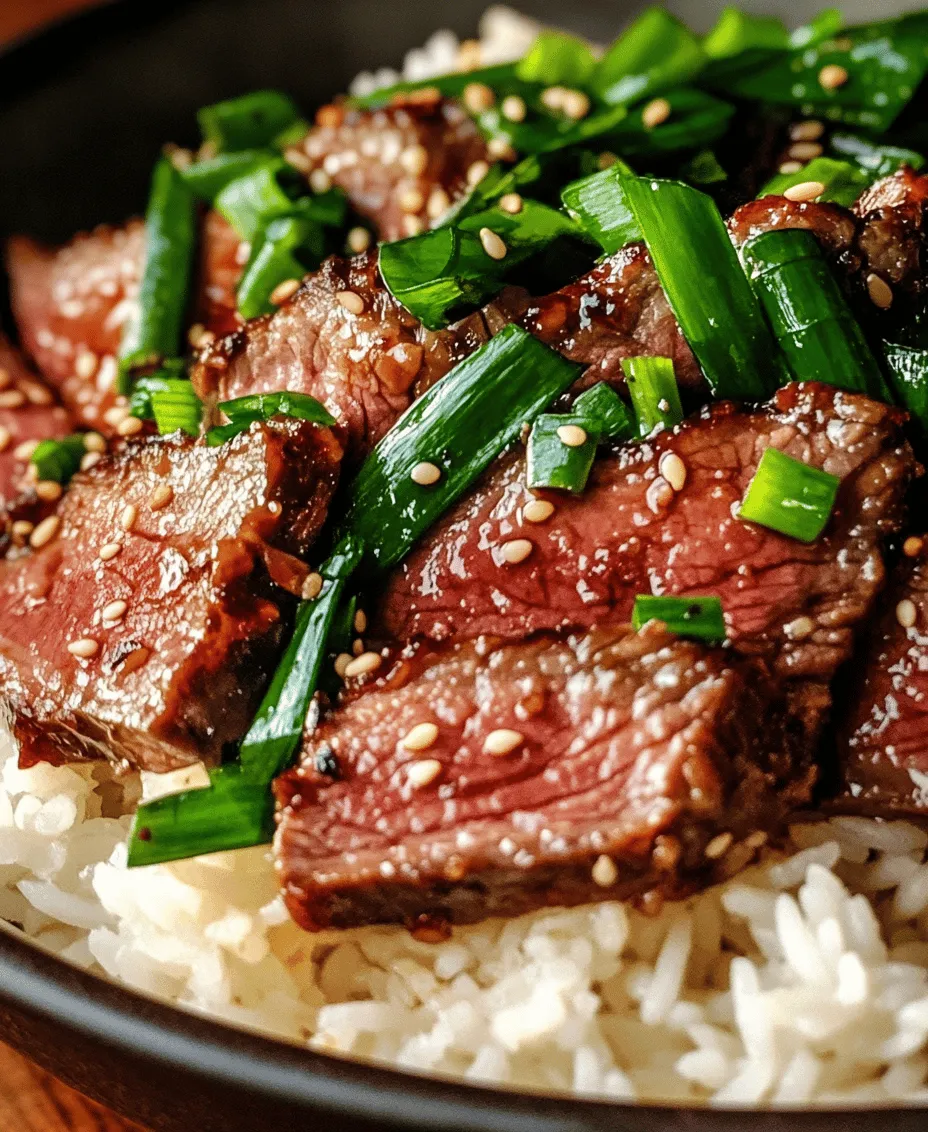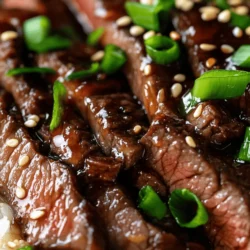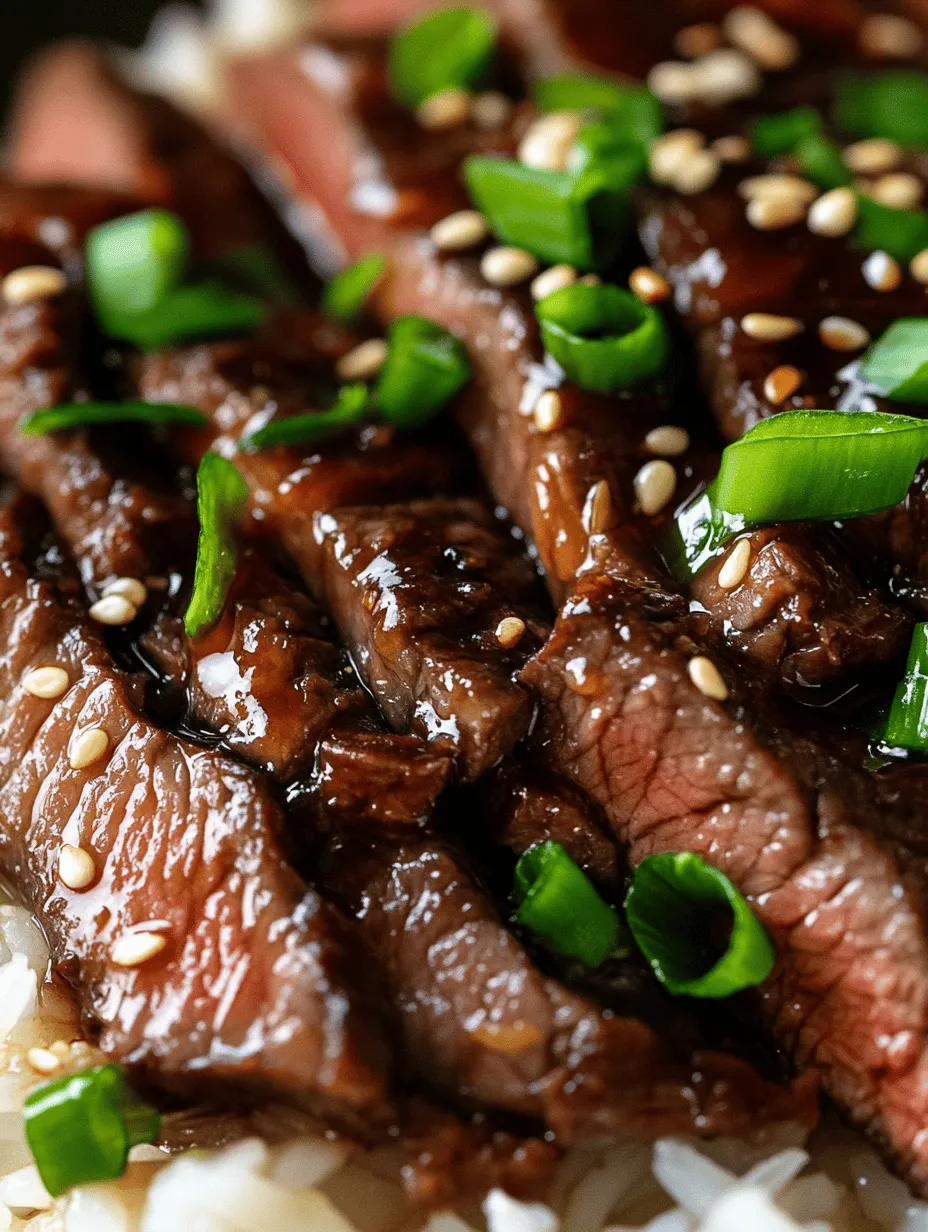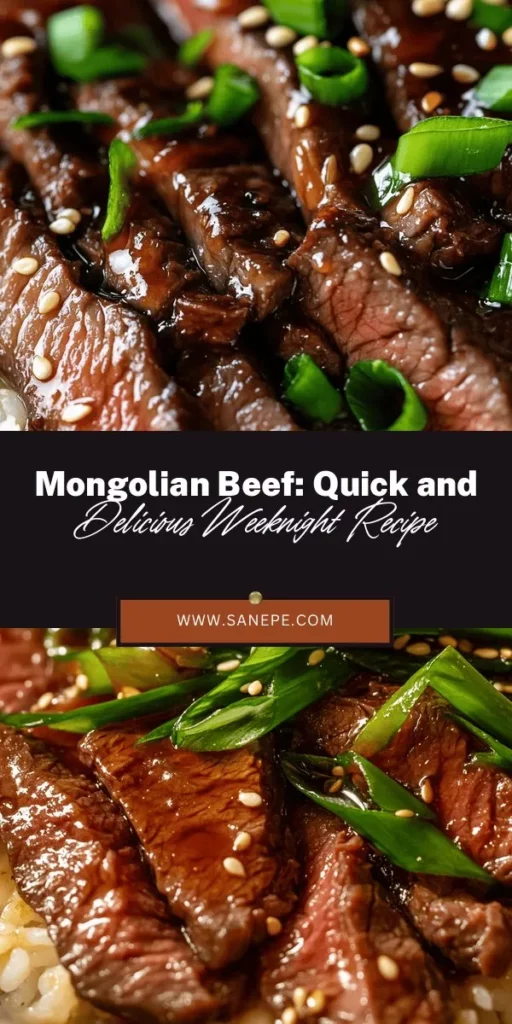Introduction
Discover the flavors of Mongolian cuisine with this delightful Mongolian Beef recipe. Combining tender flank steak with a savory sauce and aromatic ingredients, this dish is not only quick to prepare but also perfect for a weeknight dinner or a special occasion. In just 30 minutes, you can create a meal that will impress your family and friends, showcasing your culinary skills while indulging their taste buds in an unforgettable experience.
Mongolian Beef is more than just a dish; it’s a delicious representation of a culinary tradition that has evolved over time. The rich flavors and satisfying textures make it a favorite among many, and it’s easy to see why. Whether you are a seasoned chef or a novice in the kitchen, this recipe will guide you through every step, ensuring that you can recreate this Asian delight in your own home.
Understanding Mongolian Beef
Brief History of Mongolian Cuisine
Mongolian cuisine is deeply rooted in the nomadic lifestyle of the Mongolian people, who traditionally relied on livestock for sustenance. Meat, particularly lamb, beef, and horse meat, forms the cornerstone of their diet, often complemented with dairy products like milk, yogurt, and cheese. The harsh climate of Mongolia has also influenced its food culture, leading to a preference for hearty dishes that provide warmth and energy.
Over time, as cultures have mingled, particularly in urban centers, Mongolian cuisine has adopted and adapted influences from neighboring countries like China and Russia. This has led to a diverse array of dishes that reflect a blend of flavors and cooking techniques. Mongolian Beef is one such dish that has transcended its origins, becoming a staple in Asian-American cuisine.
Overview of How Mongolian Beef Has Evolved in Western Cuisine
Mongolian Beef, as we know it today, is a dish that has significantly evolved from its original Mongolian roots. It is often characterized by its tender beef, coated in a glossy, sweet-savory sauce. The dish is a popular item in Chinese restaurants in the West, where it has been tailored to suit local tastes. While traditional Mongolian dishes are often more rustic and hearty, the Western version emphasizes tenderness and a balance of sweet and savory flavors, making it accessible and appealing to a wider audience.
The dish typically features flank steak, a cut that is known for its flavor yet can be tough if not prepared correctly. Thus, the cooking method is designed to enhance tenderness while delivering a symphony of flavors that pay homage to its origins. Whether served over rice or alongside vegetables, Mongolian Beef has become an iconic representation of Asian-inspired cuisine that continues to delight palates around the globe.
Comparison with Similar Asian Dishes
Mongolian Beef can be compared to several other popular Asian dishes, each offering a unique take on meat and sauce combinations. For example, you might find similarities with Beef and Broccoli, which features tender beef alongside fresh broccoli in a savory soy-based sauce. However, Mongolian Beef tends to lean more towards sweetness due to the addition of brown sugar and sometimes honey, whereas Beef and Broccoli focuses more on a salty, umami profile.
Another dish worth mentioning is Kung Pao Beef, which incorporates peanuts and a distinct spice profile. While both dishes use beef as the primary ingredient, Kung Pao is known for its heat and nutty flavor, contrasting with the sweetness of Mongolian Beef.
Furthermore, dishes like Teriyaki Beef share a commonality in their use of soy sauce and sweet elements but often include a thicker glaze and additional ingredients like sake or mirin, which provide a different taste experience. The versatility of beef in Asian cuisines allows for endless variations, but Mongolian Beef stands out for its simplicity and the way it highlights the quality of the meat itself.
Ingredients Breakdown
To create the perfect Mongolian Beef, it is essential to understand the role of each ingredient in the dish. Here’s a detailed examination of the key components that contribute to its delicious flavor profile.
Flank Steak: Tips for Selecting and Preparing
Flank steak is the star of this recipe, known for its robust flavor and versatility. When selecting flank steak, look for a cut that is bright red with a good amount of marbling, which indicates tenderness and flavor. Avoid any cuts that appear dull or have excessive fat.
To prepare the flank steak, it is crucial to slice it correctly. Always cut against the grain, as this will help break down the muscle fibers and yield a tender final product. Aim for thin slices, about 1/4 inch thick, for the best texture. If the meat is slightly frozen, it can be easier to slice, allowing for more precise cuts.
Cornstarch: Role in Texture and Flavor
Cornstarch serves a dual purpose in this recipe. First, it helps to tenderize the flank steak during the marinating process, allowing the meat to absorb moisture and flavors. Additionally, once coated on the beef, it creates a light crust when cooked, enhancing the dish’s overall texture. This technique, often referred to as “velveting,” is common in many Chinese dishes and is key to achieving that desirable tender bite.
Garlic and Ginger: Health Benefits and Flavor Profile
Garlic and ginger are aromatic powerhouses that not only elevate the flavor of Mongolian Beef but also provide numerous health benefits. Garlic is known for its immune-boosting properties and ability to lower blood pressure, while ginger can aid digestion and reduce inflammation.
In this dish, fresh garlic and ginger are integral for creating a depth of flavor. They bring warmth and a slight spiciness, complementing the sweetness of the sauce beautifully. When preparing, it’s best to mince or finely grate these ingredients to ensure they blend seamlessly into the dish.
Soy Sauce: Importance of Low Sodium Varieties
Soy sauce is a staple in many Asian cuisines and an essential ingredient in Mongolian Beef. It provides the salty umami flavor that balances the sweetness of the brown sugar. When selecting soy sauce, opt for low sodium varieties to control the overall saltiness of the dish while still achieving that rich flavor.
Using low sodium soy sauce allows for better balance, especially since other ingredients like brown sugar and rice vinegar contribute their own flavors. This consideration is particularly important for those monitoring their sodium intake without sacrificing taste.
Brown Sugar: Balancing Flavors
Brown sugar is a crucial ingredient that adds sweetness and depth to the sauce. The molasses present in brown sugar gives it a rich flavor that complements the savory elements of the dish. Adjusting the amount of brown sugar can help you find the perfect balance for your palate, whether you prefer a sweeter taste or a more pronounced savory profile.
Green Onions: Different Parts and Their Uses
Green onions (or scallions) are not only used for flavoring but also serve as a beautiful garnish, adding a pop of color to your dish. The green tops are often sliced thinly and sprinkled over the finished meal, providing a fresh crunch and mild onion flavor.
When preparing green onions, make use of both the white and green parts. The white part can be sautéed with the beef for a richer flavor, while the green tops are perfect for garnishing. This dual usage enhances the dish’s visual appeal and adds layers of flavor.
Rice Vinegar and Sesame Oil: Enhancing the Dish’s Authenticity
Rice vinegar is a slightly sweet and mild vinegar that brightens the overall flavor of the dish. It cuts through the richness of the beef and balances the sweetness of the brown sugar, creating a harmonious taste profile. When using rice vinegar, a small amount goes a long way, so it’s essential to measure accurately.
Sesame oil is another key ingredient that adds a distinct nuttiness to the dish. It’s often used as a finishing oil, drizzled over the cooked beef just before serving to enhance the aroma and flavor. A little sesame oil can add a lot, so start with a small amount and adjust to taste.
Optional Sriracha: Adjusting Spice Levels to Taste
While Mongolian Beef is traditionally not a spicy dish, you can easily customize it to suit your preferences by adding sriracha or another chili sauce. The heat from the sriracha can enhance the overall flavor, making the dish more dynamic. Start with a small drizzle and adjust according to your taste, ensuring that the other flavors remain balanced.
Preparation Steps
Now that we’ve covered the ingredients, it’s time to dive into the preparation steps that will lead you to a delicious Mongolian Beef dish. Follow these comprehensive guidelines to ensure your cooking process is seamless and successful.
How to Properly Slice Flank Steak Against the Grain
As mentioned earlier, slicing flank steak against the grain is crucial for achieving tenderness. To do this, locate the direction of the grain (the lines running through the meat). Position your knife perpendicular to these lines and slice thinly, about 1/4 inch thick. This technique breaks down the muscle fibers, resulting in a more tender bite.
If you’re unsure about the grain direction, it can help to look for the lines in the meat before cooking. Slicing correctly will make a noticeable difference in the dish’s texture, ensuring that each piece of beef is easy to chew and bursting with flavor.
Importance of Marinating the Beef with Cornstarch
After slicing the flank steak, it’s time to marinate it. In a mixing bowl, combine the sliced beef with a tablespoon of cornstarch and a light drizzle of soy sauce. Toss the meat until it is well coated and let it sit for about 15-20 minutes. This marinating process not only helps tenderize the beef but also allows it to absorb the flavors from the soy sauce.
During this time, you can prepare the sauce and other ingredients, which will streamline the cooking process once you start cooking the beef.
Making the Sauce: Step-by-Step Instructions and Tips
To create the delicious sauce that will coat your Mongolian Beef, you’ll need to combine several ingredients. In a separate bowl, whisk together the following:
– 1/2 cup low sodium soy sauce
– 1/3 cup brown sugar
– 1 tablespoon rice vinegar
– 1 teaspoon sesame oil
– 1-2 cloves minced garlic
– 1 teaspoon grated ginger
– Optional: sriracha to taste for added heat
Whisk the ingredients until the brown sugar is completely dissolved. This sauce will become the flavorful glaze that envelops your beef, so it’s important to ensure it’s well mixed.
Once the sauce is prepared, set it aside. The next step is to heat your cooking oil in a skillet or wok over medium-high heat. When the oil is hot, add the marinated flank steak in batches to avoid overcrowding the pan. This step is vital for achieving a good sear, which enhances flavor.
As you cook the beef, aim for a quick stir-fry, allowing it to brown for about 2-3 minutes before adding the prepared sauce. The sauce will thicken quickly, creating a beautiful sheen on the beef that tantalizes the senses.
With these initial steps, you are well on your way to creating a mouthwatering Mongolian Beef dish that showcases the best of Asian cuisine. Enjoy the process, and get ready to savor the delightful flavors that await!

Techniques for Cooking Beef in Batches to Achieve the Perfect Sear
When preparing your Mongolian Beef Delight, achieving that perfect sear on the beef is essential for enhancing the dish’s flavor and texture. Cooking in batches is the best technique to ensure each piece of beef is given enough space to brown evenly. Here’s how to do it like a pro:
1. Preheat the Pan: Start by heating your skillet or wok over medium-high heat. A hot pan allows the beef to sear rather than steam, which is crucial for developing that desirable crust.
2. Oil Selection: Use a high smoke point oil, such as vegetable or canola oil, to prevent burning. A tablespoon should be enough for the first batch.
3. Batch Cooking: Divide your beef into manageable portions. Overcrowding the pan can lower its temperature, resulting in steaming rather than searing. Sear the beef in batches for about 2-3 minutes per side until browned. Once done, transfer it to a plate and repeat with the remaining beef.
4. Resting: Allow the seared beef to rest briefly before combining it with the sauce. This helps lock in juices, ensuring a succulent final dish.
Sautéing Aromatics: Timing and Techniques for Maximized Flavor
Aromatics like garlic and ginger are pivotal in building the flavor profile of your Mongolian Beef Delight. Here’s how to sauté them perfectly:
1. Timing: Add the aromatics to the pan after removing the beef. Sauté them for about 30 seconds to a minute. This short cooking time allows their essential oils to release without burning, which can turn their flavor bitter.
2. Chopping Techniques: Chop garlic and ginger finely to maximize their surface area, allowing them to infuse the oil more effectively. Consider using a microplane for ginger to achieve a smooth consistency.
3. Flavor Boost: If you prefer a deeper flavor, consider adding a dash of soy sauce or a splash of broth to the aromatics while they sauté. This will deglaze the pan and help lift any browned bits, intensifying the overall taste of the dish.
Combining Ingredients: Ensuring Even Coating of Sauce
Once your beef and aromatics are ready, it’s time to bring everything together. Here’s how to ensure an even coating of sauce:
1. Sauce Preparation: Make sure your sauce is well-mixed before adding it to the beef. This ensures that all ingredients, including sugar, soy sauce, and any other flavorings, are evenly distributed.
2. Combining: Add the beef back to the pan along with the sauce. Use a spatula to stir gently, ensuring that every piece of beef is coated evenly. The heat should be medium-low at this stage, allowing the sauce to thicken slightly without burning.
3. Tossing Technique: To achieve a more thorough coating, use a tossing motion rather than stirring. This helps the sauce cling better to the beef without breaking it apart.
Finishing Touches with Green Onions and Sesame Seeds
The final touches of your Mongolian Beef Delight can elevate both its presentation and flavor:
1. Green Onions: Slice green onions thinly, using both the green and white parts for added texture and flavor. Add them to the dish just before serving, allowing them to retain their crispness.
2. Sesame Seeds: Toasting sesame seeds in a dry pan for a few minutes brings out their nutty flavor. Sprinkle them over the finished dish for added crunch and visual appeal.
Serving Suggestions
Your Mongolian Beef Delight is ready to be plated! Here are some creative ideas for serving it:
– Recommended Side Dishes: Pair your Mongolian Beef with steamed jasmine rice or fluffy white rice to soak up the delicious sauce. Alternatively, serve it with stir-fried noodles or fresh vegetable stir-fries, like bok choy or bell peppers, for a colorful plate.
– Garnishing Tips: Enhance visual appeal by placing the beef on a bed of rice and topping it with the green onions and toasted sesame seeds. Consider adding a few fresh cilantro leaves for a pop of color and freshness.
– Pairing with Beverages: This dish pairs beautifully with a light-bodied red wine, such as Pinot Noir, which complements the savory flavors. If you prefer non-alcoholic options, consider a refreshing green tea or iced tea with lemon to balance the richness.
Nutritional Information
Understanding the nutritional content of your Mongolian Beef Delight can help you enjoy it while considering your dietary goals:
– Nutritional Breakdown: On average, a serving of Mongolian Beef Delight contains approximately 350-400 calories, 30g of protein, 20g of fat, and 10g of carbohydrates. The exact values can vary depending on portion sizes and specific ingredient choices.
– Health Benefits:
– Beef: Rich in protein and essential nutrients like iron and zinc, beef supports muscle growth and overall health.
– Green Onions: Packed with antioxidants and vitamins, they can aid in digestion and boost immunity.
– Ginger and Garlic: Both are known for their anti-inflammatory properties and can contribute to better heart health.
– Adjusting for Dietary Needs: For those looking to reduce carbohydrates, serve the beef over cauliflower rice instead of traditional rice. If you need a gluten-free option, ensure you use gluten-free soy sauce or tamari.
Tips for Customization
Mongolian Beef Delight is a versatile dish that can be easily customized to suit different tastes:
– Vegetarian or Vegan Adaptations: Substitute beef with jackfruit, seitan, or mushrooms for a plant-based version. Marinate them similarly to the beef to infuse flavor.
– Alternative Proteins: Chicken or pork can work well in this recipe. Adjust cooking times accordingly, as they may cook faster than beef.
– Adjusting Flavor Profiles: Experiment with different sauces. For instance, adding hoisin sauce can introduce a sweet and tangy element, while using sriracha can spice things up.
– Seasonal Ingredient Swaps: Utilize seasonal vegetables like snap peas or asparagus to add freshness and color to the dish, enhancing both flavor and nutrition.
Conclusion
Mongolian Beef Delight is not only a flavorful dish but also a versatile recipe that can cater to various dietary preferences. With its rich taste and quick preparation time, this meal is perfect for busy weeknights or special occasions. By mastering the techniques for searing beef, sautéing aromatics, and combining ingredients, you can create a restaurant-quality dish in the comfort of your home.
Embrace the joy of cooking and the satisfaction of sharing this delicious meal with your loved ones. Whether you stick to the classic recipe or customize it to suit your needs, Mongolian Beef Delight is sure to become a favorite, allowing you to explore and enjoy the vibrant flavors of Mongolian cuisine.


